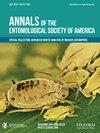昆虫类的味觉:身体位置
IF 1.8
3区 农林科学
Q1 ENTOMOLOGY
引用次数: 1
摘要
摘要本文综述了哪些昆虫类群中哪些身体部位具有味觉功能。口器、触角和跗骨的味觉证据非常普遍。通常具有味觉功能的口腔是上唇,包括唇瓣和唇须,上颌骨,包括唇盖和上颚须,咀嚼者的上唇或唇腭裂的内表面,以及半翼龙的唇腭裂/唇腭裂内部,它们有尖锐的吮吸口器。用下颚品尝的情况尚未发现,用下咽品尝的情况也很少报道。触角的使用在苍蝇中并不常见,但在鳞翅目、膜翅目、甲虫和昆虫中很常见。尽管用腿品尝,尤其是用跗骨品尝,主要是针对苍蝇和鳞翅目物种,但也有证据表明,多种甲虫、蚱蜢和半翅目昆虫,以及一种蟑螂、蚂蚁和蜜蜂都有这种味道。某些种类的苍蝇、鳞翅目昆虫、膜翅目昆虫、直翅目昆虫和齿形类动物的味觉功能得到了支持。对翅膀味道的研究要少得多,但在一些苍蝇物种中已经有记录。对于任何物种或任何身体部位的古颌目、Dermaptera、Mantodea、Mecopera、Phasmatodea、Megaloptera、Neuroptera、Phthiraptera、Psocoptera、Siphonaptera,以及Raphidiptera、Strepsiptera、Embioptera、Notoptera和Zoraptera,味道仍然没有研究。在全代谢组昆虫中,幼虫并不经常被检查,只有一些种类的鳞翅目昆虫、苍蝇和甲虫除外。即使是鳞翅目和甲虫幼虫,对触角和腿的味觉研究也不常见。本文章由计算机程序翻译,如有差异,请以英文原文为准。
Gustation Across the Class Insecta: Body Locations
Abstract This review summarizes which body parts have taste function in which insect taxa. Evidence of taste by mouthparts, antennae, and tarsi is widespread. Mouthparts that commonly have taste function are the labium, including the labella and labial palps, the maxillae, including the galeae and maxillary palps, the inner surface of the labrum or clypeolabrum of chewers, and inside the precibarium/cibarium of hemipterans, which have piercing-sucking mouthparts. Tasting with mandibles has not been found, and tasting with the hypopharynx is seldom reported. Use of the antennae appears uncommon among fly species, but common among species of lepidopterans, hymenopterans, beetles, and bugs. Although tasting with legs, especially tarsi, is reported mostly for fly and lepidopteran species, there is also evidence of it for multiple species of beetles, grasshoppers, and hemipterans, and one species of a roach, an ant, and a bee. Ovipositor taste function has been supported for some species of flies, lepidopterans, hymenopterans, orthopterans, and odonates. Taste by wings has been much less studied, but has been documented in a few fly species. Taste remains unstudied for any species or any body parts of Archaeognatha, Dermaptera, Mantodea, Mecoptera, Phasmatodea, Megaloptera, Neuroptera, Phthiraptera, Psocoptera, Siphonaptera, as well as Raphidioptera, Strepsiptera, Embioptera, Notoptera, and Zoraptera. Across holometabolous insects, larvae have not often been examined, the exception being some species of lepidopterans, flies, and beetles. Taste studies of antenna and legs are uncommon for even lepidopteran and beetle larvae.
求助全文
通过发布文献求助,成功后即可免费获取论文全文。
去求助
来源期刊
CiteScore
4.90
自引率
0.00%
发文量
25
审稿时长
6-12 weeks
期刊介绍:
The Annals of the Entomological Society of America exists to stimulate interdisciplinary dialogue across the entomological disciplines and to advance cooperative interaction among diverse groups of entomologists. It seeks to attract and publish cutting-edge research, reviews, collections of articles on a common topic of broad interest, and discussion of topics with national or international importance. We especially welcome articles covering developing areas of research, controversial issues or debate, and topics of importance to society. Manuscripts that are primarily reports of new species, methodology, pest management, or the biology of single species generally will be referred to other journals of the ESA. The most important criteria for acceptance are quality of work and breadth of interest to the readership.

 求助内容:
求助内容: 应助结果提醒方式:
应助结果提醒方式:


